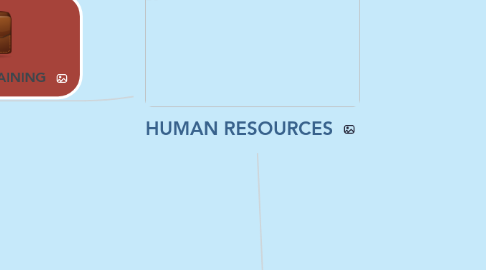
1. EMPLOYEE TRAINING
1.1. Manager's Role in Employee Training
1.1.1. development
1.1.2. new-employee orientation
1.1.2.1. address common matters
1.1.2.2. address organization's structure & leadership, benefits, performance appraisal process, dress code, parking, facility security, infection control, universal precautions
1.1.3. practical education acquired through experience
1.1.4. responsibility for maintaining & imporving
1.2. Manager as a teacher
1.2.1. most qualified individual & readily available instructor
1.2.2. more one teaches, the better it can be taught in future
1.2.3. acquire knowledge of adult learning principles
1.2.4. managerial delegation
1.3. Determining Departmental Learning Needs
1.3.1. Employee Training Within a Department
1.3.1.1. learn better involved in the process
1.3.1.2. quickly & more accurately absorb material
1.3.1.3. training should be practical and immediately applicable
1.3.2. learner's motivation is key to the eventual success of training
1.3.3. Cross-training for Efficiency
1.3.3.1. flexibility
1.3.3.2. requires time & effort
1.3.3.3. individuals gain greater interests & challenges associated with their work
1.3.4. On-the-Job Training
1.3.4.1. sometimes best available approach
1.3.4.2. step-by-step instructions on how to accomplish a task while actually performing it
1.3.5. Effective Mentoring
1.3.5.1. effective if officially sanctioned
1.3.5.2. least costly development tools
1.3.5.3. valuable facilitator & source of advice & guidance
1.3.6. Developing Potential Managers
1.3.6.1. supervisor's responsibility is to help identify & develop new managers
1.3.6.2. succession planning
1.3.6.3. requires serious & progressively more responsible delegation
1.4. How Human Resources Can Help
1.4.1. work with supervisors to diagnose particular problems & determine the kinds of training & education
1.4.2. provide certain kinds of needed training
1.4.3. secure the involvement of other in-house training expertise
1.4.4. identify external sources for specifically required training
1.4.5. determine how these sources are accessed
1.4.6. guide employees in using an organization's tuition assistance program
1.4.7. determine whether the needs assessments that were conducted were accurate
1.4.8. whether targeted skills have been learned & incorporated in new behavior
1.4.9. assess what has been learned & how the results can support the next cycle of training
2. MANAGER-EMPLOYEE RELATIONSHIP
2.1. The Heterogeneous Work Group
2.1.1. responsible for several levels of staff
2.1.2. managing people with diverse backgrounds
2.1.3. multiple levels of education
2.1.4. significant differences in work ethic
2.2. Employee Participation and Input
2.2.1. consultative manager
2.2.1.1. honest
2.2.1.2. conscientious
2.2.1.3. completely well intended
2.2.2. authoritarianism in management
2.2.2.1. boss is only person in charge & obeyed without question-- in most settings
2.2.2.2. progressively weakening, but far from gone
2.2.3. department managers
2.2.3.1. employee ideas are valued & input is needed
2.2.3.2. participation is valued & promoted
2.2.3.3. successful managers
2.3. People-centered Manager
2.3.1. production-centered
2.3.1.1. work is ordinarily highly repetitive
2.3.1.2. workstations
2.3.1.3. jobs can be rigidly defined in considerable detail
2.3.1.4. assembly line or sequence of related activities
2.3.2. manager concerns with production-centered
2.3.2.1. keeping supplies & services entering the process
2.3.2.2. primary focus is on output
2.3.3. people-centered
2.3.3.1. work often irregular & varied
2.3.3.2. jobs cannot be rigidly defined
2.3.3.3. employees control the process
2.3.4. manager concerns with people-centered
2.3.4.1. primary focus on people
2.3.4.2. people are producers, rather than machines
2.4. Visibility & Availability: Reality & Perception
2.4.1. absence impedes commucation
2.4.1.1. not accessible
2.4.1.2. employee forced to wait to get answers or take chances & act
2.4.1.3. time & material resources are wasted
2.4.2. a genuine open door: attitude & actuality
2.4.2.1. managers must back up words with actions
2.4.2.2. "door always open but dislikes interruptions"
2.4.3. easier for a first-line manager
2.4.3.1. address many problems & issues
2.4.3.2. should remain appropriately visible & available
2.4.4. show, don't tell
2.4.4.1. employees usually cannot direct access to manager
2.4.4.2. manager fails to allow employee participation
2.4.4.3. saying the rights things but not always possible to live up to the words
2.5. The Essential Downward Orientation
2.5.1. "sucking up"
2.5.2. career minded & wishes to advance within an organization
2.5.3. gain most valuable experiences for themselves
2.6. Essential Individual Relationship
2.6.1. one-to-one relationship with each employee
2.6.2. make sure no one is excluded
2.6.3. open environments & create opportunities for employees to ask questions
2.7. The Cost Ignored Employees
2.7.1. "If this person doesn't work out, there's no problem-- I can always hire another one'
2.7.2. contribute to turnover
2.7.3. losing an employee include the value of output that is lost while a position remains vacant
2.7.4. unwelcomed or excluded employees are unlikely to remain loyal or maintain employment
3. POSITION DESCRIPTION
3.1. Position Analyis
3.1.1. selection
3.1.2. training
3.1.3. evaluating
3.1.4. compensating
3.2. Job Identification Information
3.2.1. position title
3.2.2. department location
3.2.3. last date content of position description was verified
3.3. Job Summary
3.3.1. purpose
3.3.2. nature
3.3.3. extent of tasks performed
3.4. Principal Duties Performed
3.4.1. organized & orderly fashion
3.4.2. 5-8 different tasks or functions
3.4.3. what is done on the job
3.4.4. how the task is accomplished
3.4.5. why it is neccessary
3.4.6. what's the purpose

